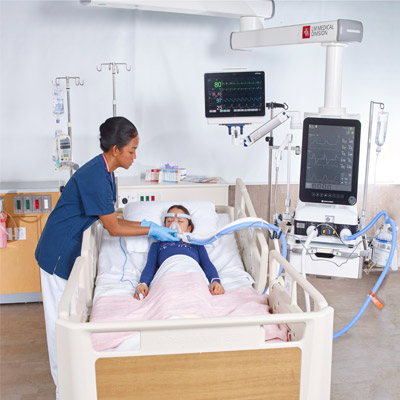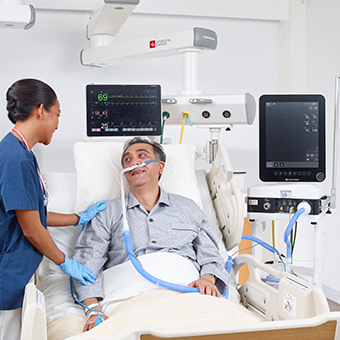Gentle Lung®️ (Lung Protection Tools)
Gentle Lung® Package for Lung Protection
Patients under mechanical ventilation may suffer from ventilator-induced lung injury (VILI). This may be caused by inappropriate tidal volume (ARDSnet), inappropriate driving pressure (Amato, et al. NEJM 2015), and inappropriate PEEP (Briel M, et al. JAMA. 2010). Lung protective ventilation is a well established practice not only in ARDS patients but also in postoperative patients (Kacmarek Anesthesiology 2018).
NKV-550 ventilator offers Gentle LungTM package, which consists of four convenient tools for clinicians to practice lung protective ventilation:
Recruitability Assessment App: Tell Whether Your Patient Will Benefit From Lung Recruitment
This app provides a guided tool for clinicians to quickly assess whether or not a particular patient will benefit from lung recruitment. The tool is easy to use. At the end of the procedure, the ventilator will display recruitable lung volume and gain in compliance.
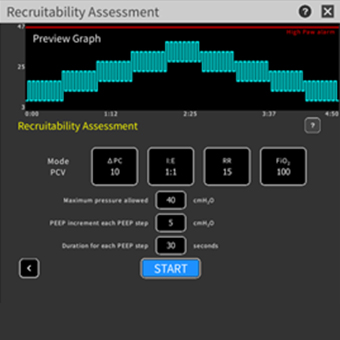
Recruitment Maneuver App: Offers You a Tool to Conveniently Recruit Lungs
This app provides a guided tool for clinicians to recruit the patient’s lungs. By setting a few parameters in this app, clinicians can allow the ventilator to execute the recruitment maneuver during which the ventilator will ventilate the patient while increasing the PEEP step-by-step, eventually elevating the airway pressure to such a level that the collapsed lungs are recruited (i.e., re-opened). At the end of the procedure, the ventilator can resume normal ventilation or transition to PEEP titration, depending on the clinician’s choice.
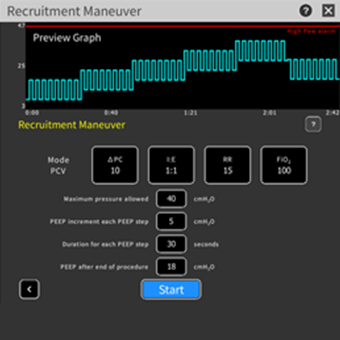
PEEP Titration App: Titrate PEEP for Your PEEP
This app allows clinicians to perform a decremental PEEP titration maneuver to help identify the lowest PEEP that provides the highest lung compliance. At the end of the procedure, clinicians can either resume normal ventilation or select Recruitment Maneuver.

Transpulmonary Pressure App: Measure Driving Pressure of Your Patient
This app allows clinicians to conveniently monitor the transpulmonary pressure (P-tp) of the ventilated patient. In addition to real time P-tp waveform, the app measures peak value, mean value, plateau value and end expiratory value of transpulmonary pressure. The app also measures the driving pressure which is the inflation pressure of transpulmonary pressure. Talmor et al have found that adjusting PEEP setting to achieve an end expiratory transpulmonary pressure of 0 to 10 cm H2O significantly improved oxygenation and respiratory compliance in patients with ARDS (Talmor NEJM 2008). Amato, et al. has found that among all variables, driving pressure is the variable that is most strongly associated with patient survival in ARDS patients (Amato, et al. NEJM 2015).
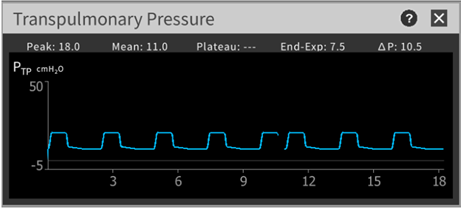
Non-invasive Ventilation
Noninvasive ventilation is being used more frequently and it has been shown to improve outcomes in appropriately selected patients. The NKV-550 Series and NKV-330 Series Ventilator from Nihon Kohden provide the clinicians with the ability to ventilate their complex patients noninvasively with increased monitoring capabilities. Whether ventilation is required in the emergency department, transport, or through patient mobilization our ventilators can help optimize your workflow.
High Flow Oxygen Therapy
Provide High-flow oxygen for All Patient Sizes From Adult to Pediatric to Neonate.
HFOT has been used to treat patients with hypoxemic acute respiratory failure, patients with COPD, neonates after extubation, and preterms with apnea.
Clinicians can now use the NKV-550 ventilator to apply HFOT through the “O2 Therapy” feature.
Compared with traditional devices of O2 therapy, the NKV-550 ventilator O2 Therapy offers three advantages:
- FiO2 delivery is accurate even at high flow rates
- Same breathing circuit and heated humidifier that they used for positive pressure ventilation can be used, eliminating the need to switch between different devices
- NKV-550 ventilator measures and displays actually delivered O2 and flow rate, providing added assurance to clinicians
Protective Control®️
Reduce Hazards for Clinicians during COVID-19 and Other Pandemics
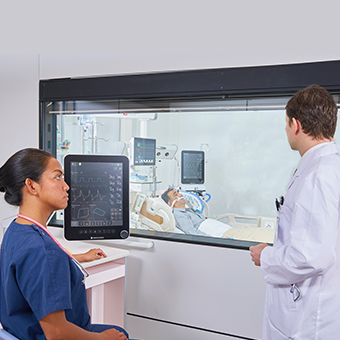 When a patient is placed in an isolation room due to contagious diseases, such as COVID-19 and Ebola, clinicians who are experts in the use of mechanical ventilators are not always in the isolation room. When the patient’s condition suddenly deteriorates, requiring a clinical expert’s immediate action to change the ventilator settings or to perform an urgent maneuver such as manual ventilation, the clinicians have to take 10-15 minutes to put on personal protection equipment (PPE) before they can enter the isolation room. While this process of donning and doffing PPE provides the best protection against coming in contact with and possibly spreading the biohazard that is present in the patient’s room, it delays the response to provide urgent care to the critically ill patient who is under mechanical ventilation. To avoid the delay in patient urgent care, clinicians may be in a hurry and may be unable to put on PPE carefully. This biohazard to clinicians was shown as a public health crisis during the COVID-19 pandemic.
When a patient is placed in an isolation room due to contagious diseases, such as COVID-19 and Ebola, clinicians who are experts in the use of mechanical ventilators are not always in the isolation room. When the patient’s condition suddenly deteriorates, requiring a clinical expert’s immediate action to change the ventilator settings or to perform an urgent maneuver such as manual ventilation, the clinicians have to take 10-15 minutes to put on personal protection equipment (PPE) before they can enter the isolation room. While this process of donning and doffing PPE provides the best protection against coming in contact with and possibly spreading the biohazard that is present in the patient’s room, it delays the response to provide urgent care to the critically ill patient who is under mechanical ventilation. To avoid the delay in patient urgent care, clinicians may be in a hurry and may be unable to put on PPE carefully. This biohazard to clinicians was shown as a public health crisis during the COVID-19 pandemic.
The NKV-550 ventilator allows clinicians to connect a second graphic user interface (GUI) to the ventilator’s main unit, in addition to the primary GUI. The second GUI can be placed outside the isolation room of a contagious patient who is under mechanical ventilation, as long as the patient is within the sight of the clinician through the room’s glass window. The clinicians can view the ventilator monitors and alarms, adjust ventilation settings and alarm settings, and audio pause the alarm sound, through this second GUI.
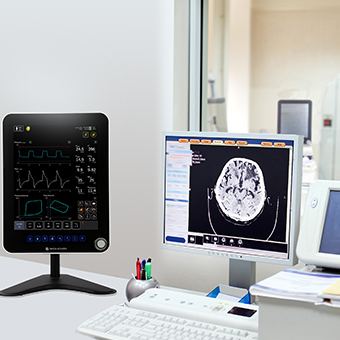 Interventional Radiological (IR) procedures have been growing year-by-year due to being less invasive, having a lower cost expenditure and facilitating faster recovery. Some patients who are undergoing IR procedures are also under mechanical ventilation. The NKV-550 ventilator with a second graphical user interface (GUI) allows the ventilator experts to stay outside of the radiological room, closely monitoring the patient’s respiratory conditions through the second GUI and through the glass window of the room at all times providing the ability to intervene immediately when needed.
Interventional Radiological (IR) procedures have been growing year-by-year due to being less invasive, having a lower cost expenditure and facilitating faster recovery. Some patients who are undergoing IR procedures are also under mechanical ventilation. The NKV-550 ventilator with a second graphical user interface (GUI) allows the ventilator experts to stay outside of the radiological room, closely monitoring the patient’s respiratory conditions through the second GUI and through the glass window of the room at all times providing the ability to intervene immediately when needed.
Intra-hospital Transport
Complex patients often require intrafacility transport to locations such as radiology, the operating room and the critical care unit. Studies have demonstrated keeping the patient on a mechanical ventilator improves outcomes and reduces adverse events. The NKV-550 Ventilator and NKV-330 Ventilator have the capability of intrafacility transport on patients that are being invasively or non-invasively ventilated. This saves time and resources as there is no need for a second ventilator (and its circuit and accessories).
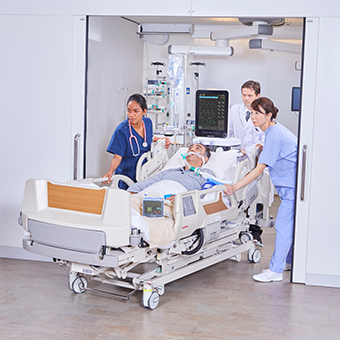
Hospital Connectivity
The NKV-550 Series Ventilator is designed to connect to a HL7 Gateway to transfer data to the HIS/CIS System. Moreover, ventilator data can transfer to designated patient monitors or through various LAN systems. Seamless integration of ventilator data helps reduce the risk of errors and improves workflow.




